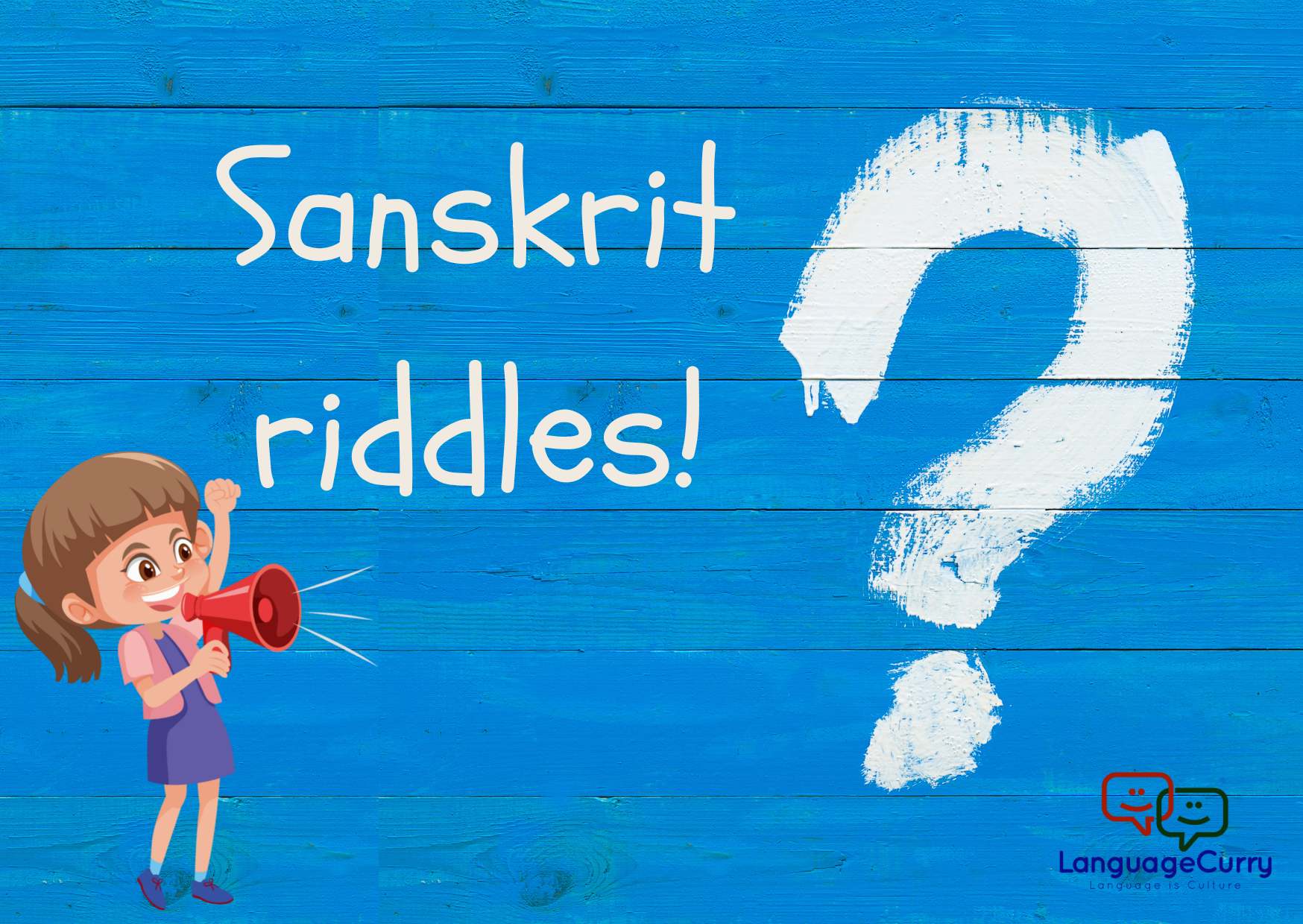Sanskrit is FUN Part 2 !!
World's oldest Sanskrit puzzle was in news recently. But can you solve 'these' fun Sanskrit puzzles today?
Riddles and puzzles have fascinated the young and old alike since time immemorial. Solving a puzzle alone is a satisfying and rewarding experience for many. Puzzles challenge one's brain and help channel one's creativity. They can be addictive and yet a healthy use of one's time and mind. When solved together they can bring people closer too.
We're sure you have solved many puzzles and riddles. But have you ever solved Sanskrit riddles? Let's try them out now!
न तस्यादिर्न तस्यान्तः मध्ये यस्तस्य तिष्ठति।
तवाप्यस्ति ममाप्यस्ति यदि जानासि तद्वद॥
na tasyādirna tasyāntaḥ madhye yastasya tiṣṭhati.
tavāpyasti mamāpyasti yadi jānāsi tadvada..
This is a riddle which says: what is that which has no beginning, no end and that which stands in the middle, you have it, so do I; do you know what it is? This is the general meaning.
But when it is understood as: What is that which has ‘न na’ in the beginning and ‘न na’ at the end and ‘य ya’ in the middle. Did you guess? If not, the answer is ‘नयन nayana ’ which, in Sanskrit means eye.
Interesting… isn’t it!
Hanuman killed Rama!!!
हनुमति हतारामे वानराः हर्षनिर्भराः।
रुदन्ति राक्षसाः सर्वे हा हारामो हतो हतः॥
hanumati hatārāme vānarāḥ harṣanirbharāḥ.
rudanti rākṣasāḥ sarve hā hārāmo hato hataḥ..
The straightforward meaning of the verse may give the sense as: When Hanuman killed Rama, the monkeys were happy. All the rakshasas wept and exclaimed, alas! alas! Rama has been killed.
How is that possible? Is there something wrong? Not really. What is intended here is not the killing of Rama but the destruction of ‘ārāma’ which means a pleasure garden.
So the verse actually means: when Hanuman destroyed the pleasure garden (hata+ārāme) the monkeys (vānarāḥ) were delighted (harṣanirbharāḥ) but the Rakshasas (rākṣasāḥ) started weeping (rudanti) and exclaimed alas! alas! (hā hā) the garden (ārāma) is destroyed (hato hatah).
अन्तर्लापिका antarlāpikā — A question that has the answer within itself
Each of the following lines is a question and the answer to each is hidden in the question itself.
कं संजघान कृष्णः kaṃ saṃjaghāna kṛṣṇaḥ?
Question: Whom (kaṃ) did Krishna kill (kṛṣṇaḥ saṃjaghāna) ?
Answer : If you join the (kaṃ) with (saṃ) and read (jaghāna) separately, it becomes kaṃsaṃ jaghāna kṛṣṇaḥ which means Krishna killed Kamsa.
In Sanskrit saṃjaghāna and jaghāna would mean the same.
का शीतलवाहिनी गङ्गा kā śītalavāhinī gaṅgā?
Question: Which (kā) is the cooling (śītalavāhinī) Ganga?
Answer: Here if you join ‘kā’ with ‘śītalavāhinī’ and read the sentence as ‘kāśītalavāhinī gaṅgā’ then you get the answer that the Ganga flowing (vāhinī) in Kashi (kāśītala) is the cooling Ganga.
कं बलबन्तं नबाधते शीतम् kaṃ balabantaṃ na bādhate śītam?
Question: Who is that strong man (balabantaṃ) whom (kaṃ) winter (śītam) does not affect (na bādhate)?
Answer : When you join the word ‘kaṃ’ with ‘balabantaṃ’ it becomes ‘kambalabantaṃ’ which means the man with a blanket (kaṃbala) is not affected by winter.
Some more Riddles and Puzzles!!!
अस्थि नास्ति शिरो नास्ति बाहुरस्ति निरङ्गुलिः।
नास्ति पादद्वयं तस्य गाढमालिङ्गति स्वयम्॥
asthi nāsti śiro nāsti bāhurasti niraṅguliḥ.
nāsti pādadvayaṃ tasya gāḍhamāliṅgati svayam..
No bone it has (asthi nāsti), nor any head (śiro nāsti)
It has arms (bāhurasti) but no fingers (niraṅguliḥ)
Nor too it has any leg (nāsti pādadvayaṃ tasya), but
It gives a warm embrace (gāḍhamāliṅgati).
Do you know the answer to this? Any guess! No? It’s your ‘shirt’. Got it?
अपदो दूरगामी च साक्षरो न च पण्डितः।
अमुखः स्फुटवक्ता च यो जानाति स पण्डितः॥
apado dūragāmī ca sākṣaro na ca paṇḍitaḥ.
amukhaḥ sphuṭavaktā ca yo jānāti sa paṇḍitaḥ..
It goes afar (dūragāmī) but has no legs (apada)
It is literate (sākṣara) but not wise (paṇḍita)
It speaks clearly (sphuṭavaktā) but has no mouth (amukha)
He who knows (yo jānāti) “what it is” is wise (sa paṇḍitaḥ).
Not that easy to guess… Isn’t it? We have now completely forgotten about it. It’s ‘a letter’ that we post that goes far of places carrying our words and on reaching it speaks all that is written on it to the person for whom it is meant.
कृष्णमुखी न मार्जारी द्विजिह्वा न च सर्पिणी।
पञ्चभर्त्री न पाञ्चाली यो जानाति स पण्डितः॥
kṛṣṇamukhī na mārjārī dvijihvā na ca sarpiṇī.
pañcabhartrī na pāñcālī yo jānāti sa paṇḍitaḥ..
It is not a cat (mārjārī) but has a black face (kṛṣṇamukhī)
It is not a snake (sarpiṇī) but has two tongues (dvijihvā)
It is not Draupadi (pāñcālī) but has five masters (pañcabhartrī)
He who knows (yo jānāti) “what it is”, is wise (sa paṇḍitaḥ).
Again something that we rarely use nowadays. It’s a 'fountain pen’ with two tongues and a black mouth. The five fingers are its five masters or controllers.
वृक्षाग्रवासी न च पक्षीराजः
त्रिनेत्रधारी न च शूलपानिः।
त्वग्वस्त्रधारी न च सिद्धयोगी
जलं च बिभ्रन् न घटो न मेघः॥
vṛkṣāgravāsī na ca pakṣīrājaḥ
trinetradhārī na ca śūlapāniḥ.
tvagvastradhārī na ca siddhayogī
jalaṃ ca bibhran na ghaṭo na meghaḥ..
It is not a bird (pakṣīrāja) but lives atop the tree (vṛkṣāgravāsī)
It is not lord Shiva (śūlapāniḥ) but has three eyes (trinetradhārī)
It is bark-clothed (tvagvastradhārī) but not an accomplished Yogi (siddhayogī)
It is not a pot (ghaṭa), nor a cloud (megha), though holds water within (jalaṃ ca bibhran).
It’s ‘Coconut’. Do you agree with me?
जात्या विहङ्गो न परं सपक्षः
शब्दायमानो गगने विहारी।
युद्धानुकूलो न गजो न चाश्वः
विविच्य नाम्ना वद किं तदेतत्॥
jātyā vihaṅgo na paraṃ sapakṣaḥ
śabdāyamāno gagane vihārī.
yuddhānukūlo na gajo na cāśvaḥ
vivicya nāmnā vada kiṃ tadetat..
It belongs to bird family (jātyā vihaṅgaḥ), has wings (sapakṣaḥ) but no feathers (na param)
It moves in the sky (gagane vihārī) and makes sound (śabdāyamānaḥ)
Fit for war (yuddhānukūlaḥ) but not an elephant (na gajaḥ) nor a horse (na ca aśvaḥ)
Think carefully (vivicya) and tell me (vada) “what it is” (kiṃ tadetat)
This must be easy for you guess. No? It’s ‘aeroplane’.
Did you enjoy reading this? If yes, then do like and share with others.
Also have you checked out Sanskrit is FUN Part 1 yet?
पुनर्दर्शनाय
punardarśanāya
You can download Language Curry to start learning Sanskrit right away! Here are the links to download: APP store Android



